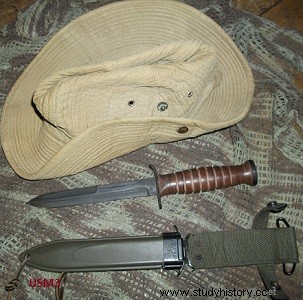
An inseparable element of the silhouette of the US soldier of the Second World War, the USM3 combat knife (USM3 Trench Knife) was originally created to arm elite troops (paratroopers, rangers, etc.). In the field, it was actually distributed to combat troops that did not have bayonets.
The first needs of the United States for a combat knife appeared during the 1st World War.
To remedy this problem, the US Army had the Trench Knifes Mle1917, Mle1918 and Mle1918 mk1 manufactured. :
At the end of the First World War, the M1917 and M1918 were decommissioned. The M1918 mk1 is kept and distributed while supplies last.
When the USA entered the war in 1941, combatants quickly felt the need to have a combat knife available. . To deal with the most urgent, the stocks of M1918 knives were distributed, while waiting to design the ideal knife. It arrived in 1943 under the name of 'US M3 Trench Knife'.
Its manufacture, although ephemeral, began in March 1943 and ended in July 1944. The total quantity of M3 manufactured in this period of fairly short time, approximately 2,590,240 were produced.
The M3 was subsequently replaced by the M4 bayonet for the US M1 carbine.
Its history does not did not stop there since it was distributed while supplies lasted. The soldiers of the French army benefited from it for many years, since the M3 took part in the combat of Korea, Indochina and Algeria.
DESCRIPTION
The M3 knife consists of 3 stamped steel parts:The blade, the guard and the pommel washer.
Its total length is 292mm (11 5/8 inches). Its blade has a double edge and has a length of 170mm (6 11/16 inches). Its width is 21.8mm for a thickness of 4.5mm.
The hilt has double quillons, one of which is bent forward to allow thumb support, its length is 57.7mm, its width is 13.3mm and it is 3mm thick.
The pommel is 6mm thick. It is attached to the blade by crushing the tang on most models. There are some manufactures where the pommel is pinned with two through nails.
Its 120m long handle is made of a stack of leather discs. Some of these washers have a smaller diameter in order to form grooves to facilitate gripping. The washers are bounded by the guard on one side and the pommel washer on the other. On some models the end washers are made of plastic instead of leather.
The total weight is about 230g.
The M3 was originally distributed with the leather M6 scabbard (M6 Scabbard) reinforced with metal additions to reinforce it. Very fragile despite its reinforcements, it was quickly replaced by an M8 fiber scabbard (M8 scabbard), then finally by the M8A1 scabbard (M8A1 Scabbard).
M6 scabbard manufacturers:Boarwood, Milsco, Moose, Sbl co, Viner Bros
